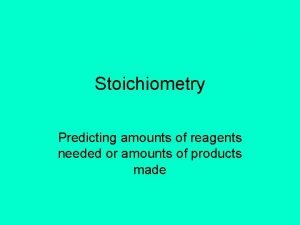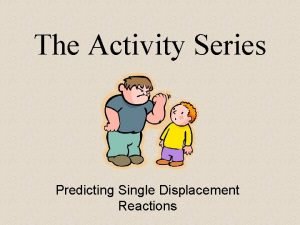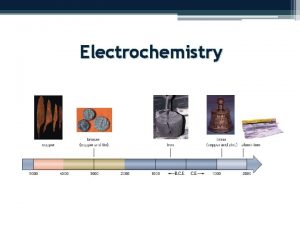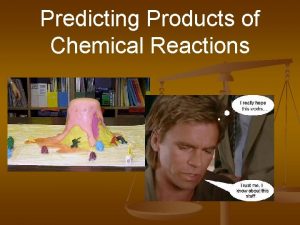Predicting Products in Chemical Reactions Types of Reactions












- Slides: 12

Predicting Products in Chemical Reactions

Types of Reactions • There are five types of chemical reactions we will talk about: 1. 2. 3. 4. 5. • Synthesis reactions _______ reactions Single displacement reactions ________ reactions Combustion reactions You need to be able to identify the type of reaction and predict the product(s)

Steps to Writing Reactions • Some steps for doing reactions 1. 2. 3. Identify the type of reaction Predict the product(s) using the type of reaction as a model Balance it Don’t forget about the diatomic elements! (Br. INCl. HOF) For example, Oxygen is O 2 as an element. In a compound, it can’t be a diatomic element because it’s not an element anymore, it’s a compound.

Cheat Sheet n. E +E=? n. C = ? n. E + C = ? n. C + C = ? n C x. H x + O 2 = ?

Decomposition Rule Exceptions • Carbonates and chlorates are special case decomposition reactions that do not go to the elements. • Carbonates (CO 32 -) decompose to carbon dioxide and a metal oxide • • Chlorates (Cl. O 3 -) decompose to oxygen gas and a metal chloride • • Example: Ca. CO 3 CO 2 + Ca. O Example: 2 Al(Cl. O 3)3 2 Al. Cl 3 + 9 O 2 There are other special cases, but we will not explore those in Chemistry I

Mixed Practice • 1. 2. 3. 4. 5. State the type, predict the products, and balance the following reactions: Ba. Cl 2 + H 2 SO 4 C 6 H 12 + O 2 Zn + Cu. SO 4 Cs + Br 2 Fe. CO 3

Total Ionic Equations n n n Once you write the molecular equation (synthesis, decomposition, etc. ), you should check for reactants and products that are soluble or insoluble. We usually assume the reaction is in water We can use a solubility table to tell us what compounds dissolve in water. If the compound is soluble (does dissolve in water), then splits the compound into its component ions If the compound is insoluble (does NOT dissolve in water), then it remains as a compound

Solubility Table

Solubilities Not on the Table n n Gases only slightly dissolve in water Strong acids and bases dissolve in water n n n Hydrochloric, Hydrobromic, Hydroiodic, Nitric, Sulfuric, Perchloric Acids Group I hydroxides (should be on your chart anyway) Water slightly dissolves in water! (H+ and OH-) Sr. SO 4 is insoluble; Be. I 2 and the products are soluble There are other tables and rules that cover more compounds than your table, we just won’t cover them in Chem. I! If you have one that is not on your chart, I will give you the solubilities.

Total Ionic Equations Molecular Equation: K 2 Cr. O 4 + Pb(NO 3)2 Pb. Cr. O 4 + 2 KNO 3 Soluble Insoluble Soluble Total Ionic Equation: 2 K+ + Cr. O 4 -2 + Pb+2 + 2 NO 3 - Pb. Cr. O 4 (s) + 2 K+ + 2 NO 3 -

Net Ionic Equations These are the same as total ionic equations, but you should cancel out ions that appear on BOTH sides of the equation Total Ionic Equation: 2 K+ + Cr. O 4 -2 + Pb+2 + 2 NO 3 - Pb. Cr. O 4 (s) + 2 K+ + 2 NO 3 Net Ionic Equation: Cr. O 4 -2 + Pb+2 Pb. Cr. O 4 (s) n

Net Ionic Equations n Try this one! Write the molecular, total ionic, and net ionic equations for this reaction: Silver nitrate reacts with Lead (II) Chloride in hot water. Molecular: Total Ionic: Net Ionic:
 Predicting products of chemical reactions
Predicting products of chemical reactions Predicting products of chemical reactions
Predicting products of chemical reactions Predicting products of chemical reactions
Predicting products of chemical reactions Combination reaction example
Combination reaction example Chemical reactions section 2 classifying chemical reactions
Chemical reactions section 2 classifying chemical reactions Section 2 reinforcement classifying chemical reactions
Section 2 reinforcement classifying chemical reactions Chemical reactions section 3 reactions in aqueous solutions
Chemical reactions section 3 reactions in aqueous solutions Reactants and products
Reactants and products Single replacement products
Single replacement products Predicting precipitation reactions
Predicting precipitation reactions How to determine if a single replacement reaction occurs
How to determine if a single replacement reaction occurs Single displacement activity series
Single displacement activity series Building redox tables
Building redox tables






















